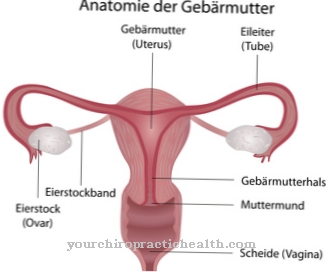Because of multiple births, heavy lifting, or an unhealthy lifestyle, it can become one Pelvic floor weakness come, which plays a crucial role in holding back urine and stool. Since the pelvic floor is a well-rehearsed system of muscles and other tissues, a weakening has various, but mostly easily treatable, consequences.
What is pelvic floor weakness?

© blueringmedia - stock.adobe.com
The pelvic floor is a layer of muscle and connective tissue about three centimeters thick, which closes off the body at the bottom. The muscles of the pelvic floor are responsible for allowing a person to lift and carry objects without losing urine or stool, so that they can hold back urine and stool and pass them at the right time.
If the pelvic floor is weak, the actual tasks of the pelvic floor can only be insufficiently fulfilled. This can lead to urinary or fecal incontinence. In a healthy state, the pelvic floor muscles are only relaxed when urinating, defecating and when the man has an erection or when a woman has vaginal intercourse.
The ability of the pelvic floor to tense reflexively is particularly important so that urine does not leak out when coughing, sneezing or hopping. In women, weak pelvic floor muscles can cause the uterus or vagina to sag.
causes
Women who have a hereditary connective tissue weakness are particularly at risk of suffering from pelvic floor weakness. It is normal for the pelvic floor muscles to lose some stability over time, but with age this can become too much and lead to pelvic floor weakness with all its consequences.
But younger women can also suffer from pelvic floor problems. Especially if a woman has given birth to several children within a relatively short period of time, the pelvic floor may weaken due to the overstretching of the muscles. Childbirth complications, such as a perineal tear, can also weaken the pelvic floor muscles.
Another possible cause of pelvic floor weakness is heavy physical labor. Chronic coughing can also permanently weaken the muscles in the pelvic floor. Lifestyle factors such as smoking or being overweight also play a role in the development of pelvic floor weaknesses that should not be underestimated.
You can find your medication here
➔ Medicines for bladder and urinary tract healthSymptoms, ailments & signs
Women are predominantly affected by pelvic floor weakness, which is why it belongs to the field of gynecology. Its typical symptoms include mild to moderate incontinence, which is due to a weakening of the tissue and muscles.
Affected women usually first notice the weakness of the pelvic floor when the bladder sphincter no longer functions reliably and small amounts of urine can leak out in an uncontrolled and undesirable manner. This occurs very often when coughing, laughing or doing sports when the body is exposed to major vibrations.
Pelvic floor weakness occurs particularly frequently in the weeks after childbirth, but it can also occur in women at an advanced age and after several births. Painful symptoms are not observed, but sufferers often report a feeling of physical insecurity.
The weakening of the muscles is noticeable and increases over time. Some patients also report a feeling that can best be compared with circulatory disorders. The area around the pelvic floor is undersupplied with blood and feels like "asleep".
When the blood circulates better again, feelings of unpleasant warmth are often reported. There are no purely external signs of pelvic floor weakness apart from the loss of urine. Psychological problems and fears of the side effects can also arise as a result of the weak pelvic floor.
Diagnosis & course
Although there are promising treatment options, especially for milder forms of pelvic floor weakness, women often wait long before they see a doctor. In most cases, this can be explained by the fact that topics such as incontinence are still taboos in society and are often hushed up.
When making a diagnosis, an anamnesis is first drawn up. This is followed by a gynecological examination. A urinalysis is carried out to rule out any urinary tract infections as the cause of the symptoms. In addition, an ultrasound examination of the pelvic organs is done.
If necessary, the pressure in the bladder and urethra can be measured using a catheter. Sometimes it is also helpful if the patient keeps a urination diary and shows this to the doctor. It records how often incontinent zeoisodes occur, what the drinking habits are, and so on.
Complications
Women who suffer from pelvic floor weakness must expect different complications in some cases. A said weak pelvic floor causes incontinence in many cases. Since this symptom is still a taboo subject in society today, the final visit to the doctor is often put on the back burner.
This can lead to further complications such as depression. Other complications that can occur in connection with pelvic floor weakness are also severe cramps and abdominal pain. In this context, those affected can get relief with painkillers. In rare cases, faecal incontinence can also occur, which can also be treated with appropriate medication.
Since pelvic floor weakness can also result from a lack of movement, those affected are in many cases significantly overweight. For this reason, there can be enormous blood pressure problems during a pelvic floor weakness, as well as restrictions in individual movement sequences. One thing is certain: the individual complications that can be caused by a weak pelvic floor are generally limited.
However, this varies greatly from patient to patient. If a patient lives a very unhealthy lifestyle, further complications can be expected, for example. These include a susceptibility to infections, fever or general muscle weakness.
When should you go to the doctor?
Pelvic floor weakness is a not uncommon consequence of pregnancy and can also occur in old age. Since the patient is no longer able to pass urine and stool in a controlled manner with this condition, he should see a doctor as soon as possible.
Simple exercises may help improve the stability of the pelvic floor again. However, these have to be shown to the patient and he has to know how they feel when he performs them correctly - so that the muscles of the pelvic floor are really trained. In addition, the doctor can check whether pelvic floor exercises bring the desired success.
In addition, a weak pelvic floor can mean that the affected person can no longer lift heavily. Only the doctor can tell him how heavy he can still lift without risk. If the pelvic floor is very weak, it may even be advisable to surgically stabilize the pelvic floor. This may give the patient a better quality of life.
Often, however, the medical examination is also about showing an affected person how they can deal with the consequences of a pelvic floor weakness in everyday life. Understandably, many people find it uncomfortable not being able to properly control their bladder and possibly intestines. The doctor can show you aids for everyday life and how to use them so that they feel better again.
Doctors & therapists in your area
Treatment & Therapy
When treating pelvic floor weakness, conservative therapy is started first. The content of this therapy depends entirely on the causes of the problems.
The first measure for a pelvic floor weakness is pelvic floor training with professional guidance. Biofeedback devices can also help to learn to specifically tense the muscles of the pelvic floor. Weight reduction and giving up cigarettes can also have the desired effect; this can be done as part of behavior therapy.
If the pelvic floor weakness occurs during the menopause, the hormone deficiency, which leads to the thinning of the tissue, can be countered by hormone therapy. If the conservative therapeutic approaches do not show the desired effect, an operation is necessary. Depending on the initial situation, subsidence of the uterus or bladder, for example, is corrected.
Outlook & forecast
A pelvic floor weakness arises from a weakening of the holding apparatus. For a good prognosis, it is therefore important to take appropriate measures to strengthen the pelvic floor again and to refrain from activities that weaken it. Regular exercise is beneficial, especially endurance sports such as walking, cycling, swimming, or running. It is better to refrain from lifting heavy loads because it tends to promote lowering of the uterus.
Women who are very overweight should work on reducing their body weight in order to relieve the pelvic floor. Regular pelvic floor training has a particularly positive effect, because it strengthens the pelvic floor and improves accompanying symptoms such as incontinence problems or effectively prevents them. However, the exercises must be carried out correctly; if necessary, they should be practiced under expert guidance.
During menopause, the weakening of the pelvic floor can also be caused by the lack of hormones that generally weaken connective tissue. In this case, appropriate hormonal treatment can improve the symptoms. In most cases, these measures are sufficient to improve the long-term outlook, but in more severe cases it can be useful to surgically stabilize the pelvic floor.
You can find your medication here
➔ Medicines for bladder and urinary tract healthprevention
In order to prevent the pelvic floor from weakening in the first place, there are various measures that effectively strengthen the muscles. Pelvic gymnastics can also be effective prophylactically and not just when symptoms first appear. Pelvic floor exercises can also be done at home. However, the training is usually more effective when done under professional guidance.
As a preventive measure, you should avoid sports that increase the pressure on the pelvic floor and thus weaken it, including sports such as tennis or jogging. To prevent weakening of the pelvic floor muscles, it is also helpful not to press unnecessarily during bowel movements and to avoid constipation.
Aftercare
The pelvic floor weakness can be treated in different ways. However, aftercare is the same for most treatment methods. Because apart from the operation, which also requires wound regeneration, aftercare is basically about the same thing after every therapy: the patient must be sensitized to the function of the pelvic floor and learn to abandon harmful behavior in everyday life and adopt positive behavioral patterns. This is possible in cooperation with the treating gynecologist, but also the family doctor or an internist.
The pelvic floor is a muscle that can be trained. Therefore, it is part of consistent aftercare to strengthen these muscles through special exercises. These exercises are easy to learn and to integrate into everyday life. After an operation, they are usually taught by a physiotherapist and can then be carried out regularly at home. This contributes to a sustainable strengthening of the pelvic floor.
Strong pressure during bowel movements has a negative effect on the stability and holding function of the pelvis. Therefore, digestive regulation can also contribute to consistent aftercare for pelvic floor weakness. A soft and voluminous stool is achieved through a sufficient amount of water and fiber. There are home remedies here to help. One remedy that has proven itself in this context is psyllium husks, which are stirred into water.
You can do that yourself
The most effective immediate measures include special insoles, which the trade offers in many different sizes. They adapt to the shape of the body and cannot be seen even in tight pants. If the pelvic floor is very weak, a replacement bandage should always be carried.
Special exercises, which are summarized under the term pelvic floor training, require a little more patience. Performed regularly, they stabilize the connective tissue and at the same time strengthen the tendons and ligaments. Since being overweight can also weaken the pelvic floor muscles, those affected should aim to reduce their weight.
In addition to special inserts, cube or ring pressers can compensate for the weak pelvic floor. Foam tampons also offer those affected effective help. These must be adjusted by the doctor and can then be changed independently by the patient. If the symptoms occur during menopause, a hormone deficiency may be the cause. This leads to the thinning of the tissue around the vagina, bladder and urethra. The deficiency is diagnosed by a specialist. He can then initiate hormone therapy and strengthen the affected tissues in this way.
Pelvic floor weakness does not only affect women. In men, too, the sagging pelvic floor leads to unwanted urine leakage. Even at the slightest sign of a weakening of this part of the body, those affected should train and stabilize it in a targeted manner.



.jpg)
.jpg)



















.jpg)



